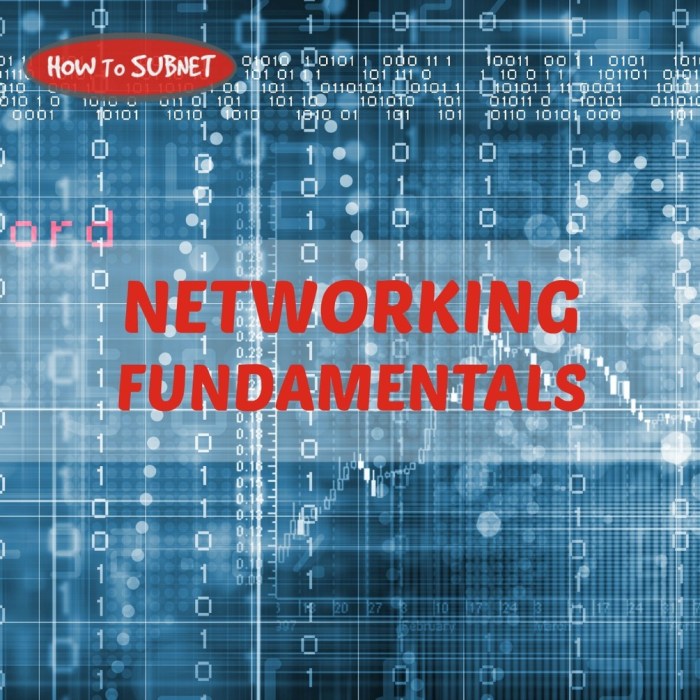Networking fundamentals rocking your network sets the stage for this enthralling narrative, offering readers a glimpse into a story that is rich in detail and brimming with originality from the outset. This comprehensive guide delves into the intricacies of network architecture, security, management, and optimization, empowering you with the knowledge to establish and maintain a robust and efficient network infrastructure.
From understanding the fundamental components of a network to implementing robust security measures, this guide provides a holistic approach to network management. It unveils the secrets of network optimization, enabling you to maximize performance and minimize downtime. Prepare to embark on a journey that will transform your network into a formidable force, ensuring seamless connectivity and unwavering reliability.
Network Architecture

A network is a system that connects multiple devices, allowing them to share resources and communicate with each other. The fundamental components of a network include routers, switches, and firewalls.
Routers connect different networks and determine the best path for data to travel. Switches connect devices within a network and forward data to the appropriate destination. Firewalls protect networks from unauthorized access and malicious activity.
Network Topologies, Networking fundamentals rocking your network
Network topologies define the physical layout of a network. Common topologies include star, bus, and ring.
- Star topology: All devices are connected to a central hub or switch.
- Bus topology: All devices are connected to a single cable.
- Ring topology: All devices are connected in a circular loop.
Network Protocols
Network protocols define the rules and procedures for communication between devices on a network. TCP/IP (Transmission Control Protocol/Internet Protocol) is the most widely used network protocol suite.
- TCP: Provides reliable, connection-oriented data transfer.
- UDP: Provides unreliable, connectionless data transfer.
Network Security

Network security is essential for protecting networks from unauthorized access, malicious activity, and data breaches.
Common Network Security Threats
- Malware: Malicious software, such as viruses, worms, and Trojans.
- Phishing: Attempting to obtain sensitive information by posing as a legitimate entity.
- Hacking: Unauthorized access to a computer or network.
Network Security Measures
Various network security measures can be implemented to protect networks.
- Firewalls: Prevent unauthorized access to a network.
- Intrusion Detection Systems (IDS): Detect and respond to security breaches.
- Encryption: Protects data from unauthorized access.
Importance of Network Security Audits and Penetration Testing
Network security audits and penetration testing are essential for identifying vulnerabilities and improving network security.
Network Management
Network management involves monitoring, maintaining, and troubleshooting networks to ensure optimal performance and security.
Network Management Tools and Techniques
- SNMP (Simple Network Management Protocol): Monitors and manages network devices.
- NetFlow: Collects and analyzes network traffic data.
- Wireshark: Captures and analyzes network traffic.
Importance of Network Monitoring and Troubleshooting
Network monitoring and troubleshooting are crucial for maintaining network health and resolving issues.
Role of Network Automation and Orchestration
Network automation and orchestration tools simplify and streamline network management tasks.
Network Optimization: Networking Fundamentals Rocking Your Network

Network optimization techniques aim to improve network performance, efficiency, and reliability.
Techniques for Network Optimization
- Traffic Shaping: Controls the flow of network traffic.
- Load Balancing: Distributes network traffic across multiple devices.
- QoS (Quality of Service): Prioritizes network traffic based on its importance.
Importance of Network Performance Monitoring and Analysis
Network performance monitoring and analysis are essential for identifying performance bottlenecks and improving network efficiency.
Role of Network Virtualization and Cloud Computing
Network virtualization and cloud computing offer flexible and scalable network solutions.
Questions Often Asked
What are the key components of a network?
The fundamental components of a network include routers, switches, firewalls, and network interface cards (NICs).
What are the different types of network topologies?
Common network topologies include star, bus, ring, and mesh. Each topology has its own advantages and disadvantages, depending on the specific requirements of the network.
What are the common network security threats?
Network security threats include malware, phishing, hacking, and denial-of-service (DoS) attacks.
What are the different network management tools?
Network management tools include SNMP (Simple Network Management Protocol), NetFlow, and Wireshark. These tools allow network administrators to monitor and troubleshoot network performance.